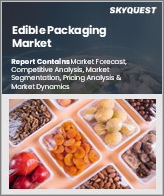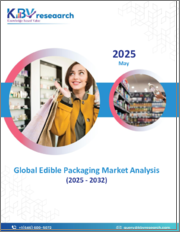
|
시장보고서
상품코드
1734496
식용 포장 시장 규모, 점유율, 성장 분석 : 소스별, 원재료별, 포장 프로세스별, 최종사용자별, 지역별 - 산업 예측(2025-2032년)Edible Packaging Market Size, Share, and Growth Analysis, By Source (Plant, Animal), By Raw material (Seaweeds & Algae, Polysaccharides), By Packaging Process, By End users, By Region - Industry Forecast 2025-2032 |
||||||
식용 포장 세계 시장 규모는 2023년에 9억 8,000만 달러로 평가되었으며, 2024년 10억 4,000만 달러에서 2032년까지 17억 3,000만 달러로 성장하고, 예측 기간(2025-2032년) 동안 CAGR 6.5%로 성장할 전망입니다.
시장 인사이트에 따르면, 기존 포장재와 관련된 폐기물을 최소화해야 할 필요성이 증가함에 따라 식용 포장에 대한 수요가 증가하고 있습니다. 소비자와 기업의 환경에 대한 인식이 높아짐에 따라 지속가능한 비즈니스로의 전환이 가속화되고 있습니다. 이러한 추세는 식용 가능한 포장 솔루션이 생태학적 우려와 폐기물을 줄이는 혁신적인 대안에 대한 소비자의 선호를 모두 충족시킬 수 있는 가능성을 보여주고 있습니다. 이러한 생분해성 및 식용 가능한 대안 개발에 투자하는 기업들은 녹색 운동의 확산에 따라 경쟁 우위를 확보할 수 있는 기회를 얻을 수 있습니다. 이러한 변화는 포장 선호도의 변화뿐만 아니라, 지속가능성과 소비자의 편의성 및 건강 지향성을 결합한 새로운 시장 기회를 반영하고 있습니다.
목차
소개
- 조사 목적
- 조사 범위
- 정의
조사 방법
- 정보 조달
- 2차와 1차 데이터 방법
- 시장 규모 예측
- 시장 가정과 제한
주요 요약
- 세계 시장 전망
- 공급과 수요 동향 분석
- 부문별 기회 분석
시장 역학과 전망
- 시장 개요
- 시장 규모
- 시장 역학
- 성장 촉진요인과 기회
- 성장 억제요인과 과제
- Porters 분석
주요 시장 인사이트
- 주요 성공요인
- 경쟁 정도
- 주요 투자 기회
- 시장 생태계
- 시장 매력 지수(2024년)
- PESTEL 분석
- 거시경제 지표
- 밸류체인 분석
- 가격 분석
식용 포장 시장 규모 : 소스별·CAGR(2025-2032년)
- 시장 개요
- 식물
- 동물
식용 포장 시장 규모 : 원재료별·CAGR(2025-2032년)
- 시장 개요
- 해조·조류
- 다당류
- 지질
식용 포장 시장 규모 : 포장 프로세스별·CAGR(2025-2032년)
- 시장 개요
- 항균제
- 나노기술
- 전기 유체 역학
- 코팅
- 미생물
식용 포장 시장 규모 : 최종사용자별·CAGR(2025-2032년)
- 시장 개요
- 식품
- 생식품·가공식품
- 베이커리 제품·제과 제품
- 냉동식품
- 음료
- 비주류
- 주류
- 의약품
식용 포장 시장 규모·CAGR(2025-2032년)
- 북미
- 미국
- 캐나다
- 유럽
- 독일
- 스페인
- 프랑스
- 영국
- 이탈리아
- 기타 유럽
- 아시아태평양
- 중국
- 인도
- 일본
- 한국
- 기타 아시아태평양
- 라틴아메리카
- 브라질
- 기타 라틴아메리카
- 중동 및 아프리카
- GCC 국가
- 남아프리카공화국
- 기타 중동 및 아프리카
경쟁 정보
- 상위 5개사의 비교
- 주요 기업의 시장 포지셔닝(2024년)
- 주요 시장 기업이 채용한 전략
- 최근의 시장 동향
- 기업의 시장 점유율 분석(2024년)
- 주요 기업 개요
- 기업 상세
- 제품 포트폴리오 분석
- 기업 부문별 점유율 분석
- 매출 전년비 비교(2022-2024년)
주요 기업 개요
- Notpla(UK)
- TIPA-Corp(Israel)
- WikiCell Designs, Inc.(USA)
- Loliware, Inc.(USA)
- Evoware(Indonesia)
- Saltwater Brewery(USA)
- Tipa Sustainable Packaging(Israel)
- Tomorrow Machine(Sweden)
- Do Eat!Barcelona SL(Spain)
- CoolCrop(India)
- Amphicell Oy(Finland)
- Mane Kancor Ingredients Private Limited(India)
- Innosieve Diagnostics B.V.(Netherlands)
- EnviGreen Biotech India Private Limited(India)
- Miyazaki Agricultural Research Institute(Japan)
- Wisefood GmbH(Germany)
- Xampla(UK)
- Sorbos(Spain)
결론과 제안
ksm 25.06.13Global Edible Packaging Market size was valued at USD 0.98 billion in 2023 and is poised to grow from USD 1.04 billion in 2024 to USD 1.73 billion by 2032, growing at a CAGR of 6.5% during the forecast period (2025-2032).
Market insights reveal a rising demand for edible packaging, driven by the escalating need to minimize waste associated with traditional packaging materials. As consumers and businesses alike become more environmentally conscious, the shift towards sustainable practices is gaining momentum. This trend highlights the potential of edible packaging solutions to address both ecological concerns and consumer preferences for innovative, waste-reducing alternatives. Companies that invest in the development of these biodegradable and edible options are likely to benefit from a competitive advantage as they align with the growing green movement. The shift reflects not just a change in packaging preferences but also an emerging market opportunity that combines sustainability with consumer convenience and health consciousness.
Top-down and bottom-up approaches were used to estimate and validate the size of the Global Edible Packaging market and to estimate the size of various other dependent submarkets. The research methodology used to estimate the market size includes the following details: The key players in the market were identified through secondary research, and their market shares in the respective regions were determined through primary and secondary research. This entire procedure includes the study of the annual and financial reports of the top market players and extensive interviews for key insights from industry leaders such as CEOs, VPs, directors, and marketing executives. All percentage shares split, and breakdowns were determined using secondary sources and verified through Primary sources. All possible parameters that affect the markets covered in this research study have been accounted for, viewed in extensive detail, verified through primary research, and analyzed to get the final quantitative and qualitative data.
Global Edible Packaging Market Segments Analysis
Global Edible Packaging Market is segmented by Source, Raw material, Packaging Process, End users and region. Based on Source, the market is segmented into Plant and Animal. Based on Raw material, the market is segmented into Seaweeds & Algae, Polysaccharides and Lipids. Based on Packaging Process, the market is segmented into Antimicrobial, Nanotechnology, Electro hydrodynamic, Coatings and Microorganisms. Based on End users, the market is segmented into Food and beverages and Pharmaceuticals. Based on region, the market is segmented into North America, Europe, Asia Pacific, Latin America and Middle East & Africa.
Driver of the Global Edible Packaging Market
The Global Edible Packaging market is expected to grow significantly during the forecast period, primarily due to the rising demand for processed foods. These foods often contain added ingredients such as salt, oil, fat, and sugar to enhance flavor and palatability. Additionally, processed items necessitate packaging solutions that offer extended shelf life beyond what edible coatings typically provide. Given the widespread consumption of processed foods, integrating edible coatings with conventional film packaging is anticipated to further propel market growth, as it addresses both the need for preservation and the growing consumer preference for sustainable packaging options.
Restraints in the Global Edible Packaging Market
Various challenges negatively affect the growth of the global edible packaging market. For instance, edible packaging is more vulnerable to fluctuating environmental conditions and necessitates specialized handling during transportation and storage, which can impede its widespread adoption. Additionally, consumers' reluctance to consume food from edible utensils or packaging may further restrict market expansion. These factors combined create a barrier to the growth of this innovative sector, as they pose logistical complications and psychological hurdles for potential users, ultimately impacting the overall acceptance and demand for edible packaging solutions in the market.
Market Trends of the Global Edible Packaging Market
The Global Edible Packaging market is witnessing a significant short-term trend driven by the rising demand for sustainable packaging solutions. Companies are increasingly exploring edible films made from protein and cornstarch as eco-friendly replacements for traditional plastics. Notably, innovations from firms like TIPA Corp, who have introduced flexible, compostable and biodegradable packaging options, are paving the way for greener alternatives. This shift is further propelled by heightened consumer preferences for chemical-free and organic products, alongside stringent government regulations targeting single-use plastics. Consequently, the market is poised for growth as businesses adapt to these evolving demands and regulatory landscapes.
Table of Contents
Introduction
- Objectives of the Study
- Scope of the Report
- Definitions
Research Methodology
- Information Procurement
- Secondary & Primary Data Methods
- Market Size Estimation
- Market Assumptions & Limitations
Executive Summary
- Global Market Outlook
- Supply & Demand Trend Analysis
- Segmental Opportunity Analysis
Market Dynamics & Outlook
- Market Overview
- Market Size
- Market Dynamics
- Drivers & Opportunities
- Restraints & Challenges
- Porters Analysis
- Competitive rivalry
- Threat of substitute
- Bargaining power of buyers
- Threat of new entrants
- Bargaining power of suppliers
Key Market Insights
- Key Success Factors
- Degree of Competition
- Top Investment Pockets
- Market Ecosystem
- Market Attractiveness Index, 2024
- PESTEL Analysis
- Macro-Economic Indicators
- Value Chain Analysis
- Pricing Analysis
Global Edible Packaging Market Size by Source & CAGR (2025-2032)
- Market Overview
- Plant
- Animal
Global Edible Packaging Market Size by Raw material & CAGR (2025-2032)
- Market Overview
- Seaweeds & Algae
- Polysaccharides
- Lipids
Global Edible Packaging Market Size by Packaging Process & CAGR (2025-2032)
- Market Overview
- Antimicrobial
- Nanotechnology
- Electro hydrodynamic
- Coatings
- Microorganisms
Global Edible Packaging Market Size by End users & CAGR (2025-2032)
- Market Overview
- Food
- Raw & Processed Food
- Bakery & Confectionery Products
- Frozen Foods
- Beverages
- Non-Alcoholic Beverages
- Alcoholic Beverages
- Pharmaceuticals
Global Edible Packaging Market Size & CAGR (2025-2032)
- North America (Source, Raw material, Packaging Process, End users)
- US
- Canada
- Europe (Source, Raw material, Packaging Process, End users)
- Germany
- Spain
- France
- UK
- Italy
- Rest of Europe
- Asia Pacific (Source, Raw material, Packaging Process, End users)
- China
- India
- Japan
- South Korea
- Rest of Asia-Pacific
- Latin America (Source, Raw material, Packaging Process, End users)
- Brazil
- Rest of Latin America
- Middle East & Africa (Source, Raw material, Packaging Process, End users)
- GCC Countries
- South Africa
- Rest of Middle East & Africa
Competitive Intelligence
- Top 5 Player Comparison
- Market Positioning of Key Players, 2024
- Strategies Adopted by Key Market Players
- Recent Developments in the Market
- Company Market Share Analysis, 2024
- Company Profiles of All Key Players
- Company Details
- Product Portfolio Analysis
- Company's Segmental Share Analysis
- Revenue Y-O-Y Comparison (2022-2024)
Key Company Profiles
- Notpla (UK)
- Company Overview
- Business Segment Overview
- Financial Updates
- Key Developments
- TIPA-Corp (Israel)
- Company Overview
- Business Segment Overview
- Financial Updates
- Key Developments
- WikiCell Designs, Inc. (USA)
- Company Overview
- Business Segment Overview
- Financial Updates
- Key Developments
- Loliware, Inc. (USA)
- Company Overview
- Business Segment Overview
- Financial Updates
- Key Developments
- Evoware (Indonesia)
- Company Overview
- Business Segment Overview
- Financial Updates
- Key Developments
- Saltwater Brewery (USA)
- Company Overview
- Business Segment Overview
- Financial Updates
- Key Developments
- Tipa Sustainable Packaging (Israel)
- Company Overview
- Business Segment Overview
- Financial Updates
- Key Developments
- Tomorrow Machine (Sweden)
- Company Overview
- Business Segment Overview
- Financial Updates
- Key Developments
- Do Eat! Barcelona SL (Spain)
- Company Overview
- Business Segment Overview
- Financial Updates
- Key Developments
- CoolCrop (India)
- Company Overview
- Business Segment Overview
- Financial Updates
- Key Developments
- Amphicell Oy (Finland)
- Company Overview
- Business Segment Overview
- Financial Updates
- Key Developments
- Mane Kancor Ingredients Private Limited (India)
- Company Overview
- Business Segment Overview
- Financial Updates
- Key Developments
- Innosieve Diagnostics B.V. (Netherlands)
- Company Overview
- Business Segment Overview
- Financial Updates
- Key Developments
- EnviGreen Biotech India Private Limited (India)
- Company Overview
- Business Segment Overview
- Financial Updates
- Key Developments
- Miyazaki Agricultural Research Institute (Japan)
- Company Overview
- Business Segment Overview
- Financial Updates
- Key Developments
- Wisefood GmbH (Germany)
- Company Overview
- Business Segment Overview
- Financial Updates
- Key Developments
- Xampla (UK)
- Company Overview
- Business Segment Overview
- Financial Updates
- Key Developments
- Sorbos (Spain)
- Company Overview
- Business Segment Overview
- Financial Updates
- Key Developments



















